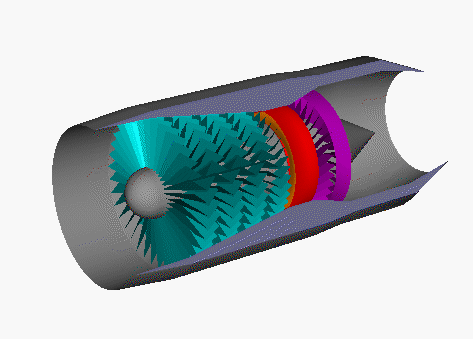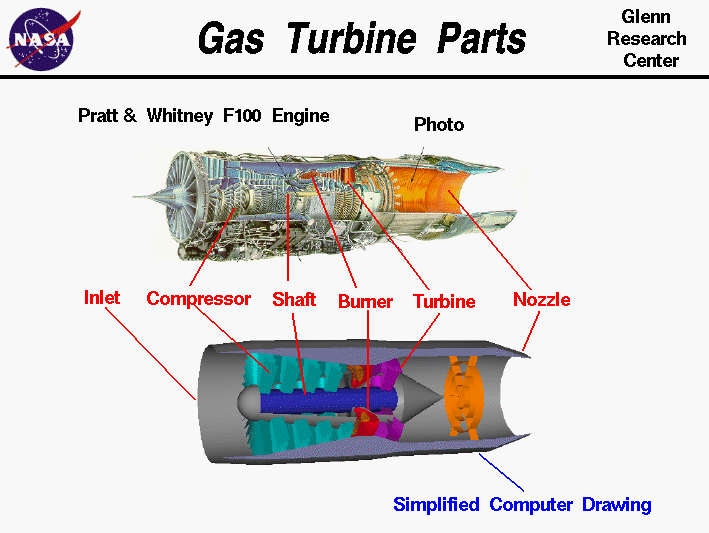
|
Animated Gas Turbine
Parts
|
Glenn
Research
Center
|







Most modern passenger and military aircraft are powered by
gas turbine engines, which are also called
jet engines. Jet engines come in a variety
of shapes and sizes but all jet engines have certain parts in
common.
On this page we have a computer model of a
basic turbojet
engine which you can animate by using the buttons below the picture.
To have a look inside, push the "Show Parts" button.
At the front of the engine, to the left, is the
inlet
At the exit of the
inlet is the
compressor, which is colored
cyan. The compressor is connected by a blue colored shaft to the
turbine,
which is colored magenta. The
compressor and the turbine are composed of many rows of small
airfoil shaped blades. Some rows are
connected to the inner shaft and rotate at high speed, while other
rows remain stationary. The rows that spin are called rotors
and the fixed rows are called stators. The combination of the
shaft, compressor and turbine is called the turbomachinery.
The "Exploded View" button shows you how these parts go together.
Between the compressor and the turbine flow path is the combustion
section or
burner,
which is colored red.
This is where the fuel and the air are mixed and burned. The hot
exhaust then passes through the turbine and out the
nozzle.
The nozzle performs two important tasks.
The nozzle is shaped to
accelerate
the hot exhaust gas to produce thrust.
And the nozzle sets the mass flow through the engine.
Here is a slide that compares our computer model with a
photo of a real, Pratt and Whitney F100 engine.,
The F100 engine is used in the F15 and F16 fighter aircraft.
As we can see in the picture, jet engines are complicated pieces of
machinery. Jets have a lot of parts which spin on a central shaft. To
enclose the spinning parts, a jet engine is shaped like a long
cylinder. At the bottom of the slide we have a much simpler computer
drawing of the engine parts.

Various parts on the photograph are labeled
and the corresponding parts on the computer drawing are indicated.
The F100 engine picture
does not show the aircraft inlet because the inlet is part of the
airframe and changes from aircraft to aircraft.
The F100 is an afterburning turbofan engine
and the flame holders for the afterburner are shown in orange in the
nozzle of the drawing. The front section of the F100 is the fan
section which is not modeled on the computer drawing.
To analyze jet engine operation, engineers have adopted a
numbering scheme for the various parts. This scheme and the
accompanying two-dimensional schematic
drawing are given on a separate slide.
You can investigate the effects of the various engine parts on jet
engine operation by using the
EngineSim
interactive Java applet.
You can vary the performance of any of the engine parts and investigate
the effects on thrust and fuel flow.
Activities:


Guided Tours
-
 Jet Engines:
Jet Engines:

-
 Parts of a Jet Engine:
Parts of a Jet Engine:

Navigation ..

- Beginner's Guide Home Page
|
